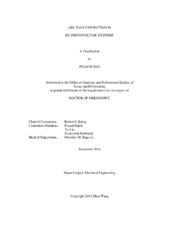| dc.description.abstract | Arc faults have always been a concern for electrical systems as they can cause fires, personnel shock hazard, and system failure. In photovoltaic (PV) systems, a large number of electrical connectors and long wire runs are expected. Combined with the high DC voltage, deterioration of the wire insulation due to aging or other circumstances such as rodent bites and abrasion due to chaffing with trees, building walls, or conduit during installation can cause electric arcs to occur. These dc arcs may result in shock hazards, fires, and system failures or faults in the PV systems. NEC 2011 includes a requirement for new rooftop arrays to include UL1699B listed arc fault current interrupters (AFCI). NEC 2014 expands this requirement to include ground-mounted arrays as well.
Existing commercialized techniques that rely on pattern recognition in the time domain, or frequency domain analysis using a Fourier Transform do not work well because the signal to noise ratio is low, and the arc signal is not periodic. Instead, wavelet transform provides a time-frequency approach to analyzing target signals with multiple resolutions.
In this work, a technique for arc fault detection photovoltaic systems by using discrete wavelet transform (DWT) for feature extraction and support vector machines for decision making is proposed.
The frequency characteristics of electric arcs in the PV systems are first studied. The fundamental feasibility of applying wavelet theory to detect arc fault and arc flash in solar PV power systems is then examined both in simulation using synthetic waveforms generated in MATLAB / Simulink and experimentally using arc waveforms measured from actual dc PV systems with/without operating inverters.
In the later chapter, a supervised learning method for arcing/non-arcing event classification using support vector machines (SVMs) is introduced. SVMs are believed to be one of the best “off-the-shelf” supervised learning algorithms. The main concept behind SVM is to create a hyperplane with a maximum margin between the two adjacent classes which helps bound the generalization error of the classification model. Different combinations of mother wavelets, decomposition levels, and kernel functions are examined in this work. Some of the strategies have shown very promising results. | en |



